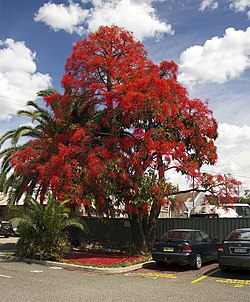| Brachychiton | |
|---|---|
 | |
| Brachychiton acerifolius | |
| Scientific classification | |
| Kingdom: | Plantae |
| Clade: | Tracheophytes |
| Clade: | Angiosperms |
| Clade: | Eudicots |
| Clade: | Rosids |
| Order: | Malvales |
| Family: | Malvaceae |
| Subfamily: | Sterculioideae |
| Genus: | Brachychiton Schott & Endl. (1832) |
| Species | |
See text | |
| Synonyms [1] | |
| |
Brachychiton (kurrajong, bottletree) is a genus of 31 species of trees and large shrubs, native to Australia (the centre of diversity, with 30 species) and New Guinea (one species). Fossils from New South Wales and New Zealand are estimated to be 50 million years old, corresponding to the Paleogene.

